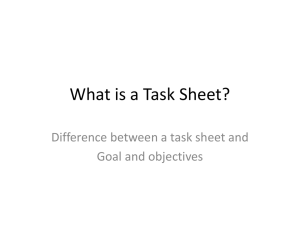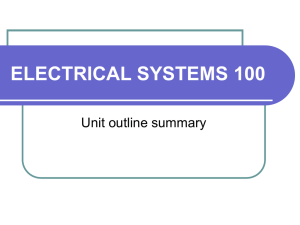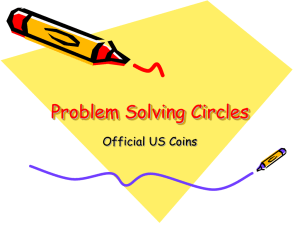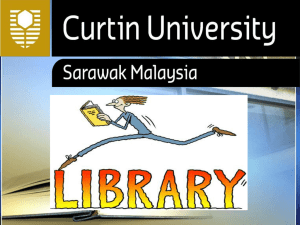Teaching Portfolio 261009
advertisement
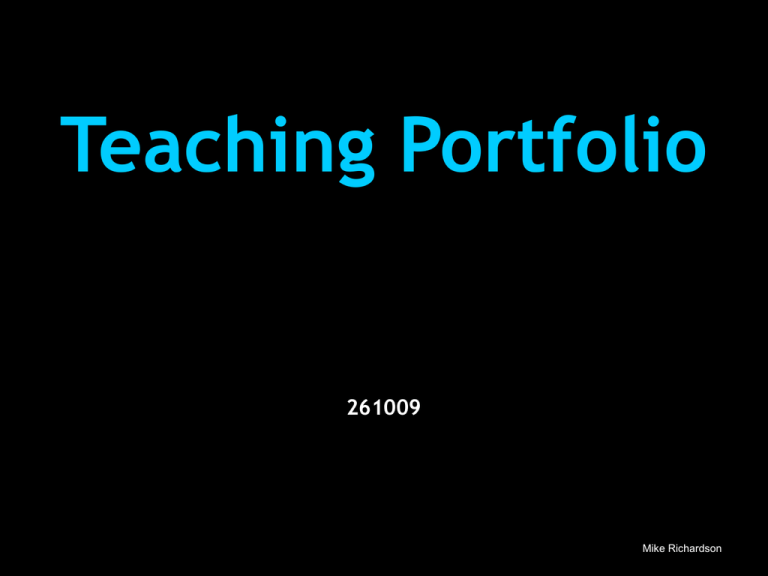
Teaching Portfolio 261009 Mike Richardson Philosophy Teaching is enjoyable because, as Francis Bacon once wrote in Religious Meditations Of Heresies 1597 “ Knowledge is Power ” I like the idea of empowering people through knowledge. Philosophy During my time at Curtin, a number of teaching / learning issues have been identified in my teaching are (architectural building technology): 1. 2. 3. 4. 5. 6. students tend not to integrate information across units the current course content has experienced slippage the credit point system is somewhat confusing units have been added ad hoc without reference to a learning framework there is no overall course philosophy or conscious distinctive for architecture at Curtin students are “learning to the test” My response to these issues is a teaching strategy based on the following concepts: 1. 2. 3. 4. 5. start with the basics and move to the detailed practical tasks are effectively taught using the 5 point Demonstration Method the five points of good exegesis Cognitive Flexibility Theory http://tip.psychology.org/spiro.html Lateral Thinking (De Bono’s ideas about water logic) http://tip.psychology.org/debono.html Record Date Employment Unit Responsibilities 2009 additional pro rata, Curtin 3rd Year Building Technology, Sem 1 Unit, coordinator, lecturing, tutoring, assessment 2008 additional pro rata, Curtin 3rd Year IA Technical Studies, Sem 2 Unit, coordinator, lecturing, tutoring, assessment 2007 2009 Half time contract Curtin 1st Year Building Technology Unit Coordinator, lecturing, tutoring , assessment 2nd & 3rd Year Building Technology tutoring , assessment 5th Year Dissertation Supervising and assessing architectural thesis students 2006 Sessional Curtin 1st Year Building Technology, Sem 2 Unit, coordinator, lecturing, tutoring, assessment 2000 2006 Sessional Curtin 1st Year Building Technology tutoring , assessment, one proxy lecture 2002 Sessional Curtin 1st Year Design, Sem 2 tutoring , assessment 2002 Sessional UWA 1st Year Design, Sem 1 tutoring, design and implementation of a project module, assessment 2001 Sessional UWA 2nd year Technology & Structures, Sem 1 site inspections, workshop supervision, assessment Record Other teaching experience: - regular lay preaching and leading engagements over the last 23 years - 12 years home schooling - supervision of approximately 10 work experience students - off shore course moderation LUCT Kuala Lumpur, Malaysia - 2 guest appearances for the Curtin ‘Brown Bag’ lecture series - guest lecture, UWA Mechanical Engineering, Design Lecture Series - designed and delivered a 10 part music appreciation series - 2 informal presentations to LUCT architectural staff, Malaysia - input into the Curtin 2010 Architectural Practice and Technology stream review Innovation Introduction of the Sugar Cube Tower project as part of my Building Technology 101 Unit coordination role, a BT 101 student now holds the world record for the tallest sugar cube tower. Integration of Spatial Science personnel to the Sugar Cube Tower project Introduction of the FAT BEV SWAM acronym and chart to BT 301 as a way of assessing the design of architectural details. A copy of this chart was requested by a member of the Architectural Accreditation Council of Australia. Practice In this section I expand on the 5 point strategy cited under Philosophy. The 2010 course review has given immediacy to my personal analysis. The following points have application in each unit as well as across the six semesters which currently make up the technology component of the undergraduate course Start with the basics and move to the detailed This idea is basic and universal to all teaching, you can’t walk until you’ve crawled, and you can’t run until you’ve walked. It is a reasonably obvious learning strategy, and is evident in the current architecture course. I think this strategy should be retained. Implementation? As with many complex systems, understanding is a process of refinement. Building Science and technology is divided into successively smaller subgroups as the course unfolds. For example, to start with all buildings are defined in terms of 3 structural systems; solid, skeletal and surface. At the end of the course we examine structures in terms of the acronymic sentence; FAT BEV SWAM, 10 principles of good detailing Basic Detailed Start with the basics and move to the detailed - example From the BT 102 Unit Outline … Practical tasks are effectively taught using the 5 point Demonstration Method There is some dispute over the word “Practice”, but I think it is an appropriate word because it conveys the intent of the stream, that is: to equip students with a set of practical skills to concentrate on the practicalities of building to put theories into practice to actually build models and to get out on site The Demonstration Method ipso facto concerns itself with teaching by demonstrating. In this application, I extend the definition to include the 5 point technique for transferring practical skills as follows: teacher exp dem / exp dem / exp dem / exp 1. 2. 3. 4. 5. Teacher explains (ideally demonstrates) Teacher demonstrates and explains Teacher demonstrates, student explains Student demonstrates and explains Student does dem student Practical tasks are effectively taught using the 5 point Demonstration Method Implementation? A real shortfall of the course is lack of office experience, this might also amount to a lack of context in which to make sense of information learnt. Practice helps give context, as it demands cogency - the laws of physics are not forgiving. With regard to (say) drafting working drawings, a task likely to fill the time of a young architectural employee, we can begin to give context by painting credible scenarios which include execution of the practical component being taught. S1 define working drawings, their purpose, how they are used, show examples S2 invent a scenario and do a simple working drawing in class explaining as you go S3 invent a scenario and do a simple working drawing in class asking questions as you go the emphasis being on student input S4 using a construction system such as Lego or Meccano, get students to design and document a simple structure. Students swap drawings and build off the plans, the designer’s intention and the builder’s outcome are compared S5 Students document part of a current project, they are given the actual design drawings and are required to work with actual consultants to produce a result which is compared to the actual outcome S6 students undertake a major project integrated across the streams 5 point Demonstration Method - example In class working drawing exercise Lecture 10 BT 102 2009: http://dbs.ilectures.curtin.edu.au/lectopia/lectopia.lasso?ut=1879&id=36274 The five points of good exegesis A cross disciplinary idea, that uses the analogy of language to guide teaching. I believe there is a certain appropriateness here because the complexities of language have a strong parallel with the complexities of architecture. Acquiring and understanding language can be divided into five categories: 1. 2. 3. 4. 5. vocabulary (learning the words) literacy (putting the words together in useful ways) history / context (development and subtleties) expansion / synthesis (the broadening) test / practice (what results from the language) As a teaching strategy, this has semester by semester application, as well as course wide application, with an emphasis on vocabulary at the beginning, and an emphasis on practice toward the end of the course V L H E T V L H E T The five points of good exegesis Implementation? This process has a course long cycle, as well as a semester long cycle. 1. vocabulary (learning the words) In any field of endeavor there are associated words. Teachers must be sure to define each new word as it is introduced, the basic aim here is to increase the number of words students have available to describe architecture 2. literacy (putting the words together in useful ways) A horrible tendency in architecture is to use the vocabulary inappropriately or in jargonistic ways. In literacy, we are trying both metaphorically and literally to learn about types of words, word patterns, sentence structure, etc. With reference to building technology this might include suites of details, modes of construction, all with a strong focus on how it has been done successfully in the past (the grammar rules already exist) 3. history / context (development and subtleties) A development of literacy is to understand context, in short it is the history component of learning, influences outside the field of study can have a dramatic impact on the development of that field. In building technology, this could be the iron / steel manufacturing process. 4. expansion / synthesis (the broadening) In language, we might be talking about current trends, psychology, editing, broadcasting etc. In Building Technology we would explore similar issues with a strong emphasis on producing actual examples. 5. test / practice (what results from the language) What is learnt must be tested in appropriate ways, how will our drawings be read? Will the proposed detail serve its purpose? This requires strong alignment with ‘real world’ situations. The five points of good exegesis - example A rough outline of the components comprising the 3 Building Technology units I have coordinated over the last 3 years showing the shifting focus from vocabulary to practice Cognitive Flexibility Theory An idea developed by Spiro, Feltovitch & Coulson, it has particular application to complex or ill structured subjects, and has been applied in the past to literary comprehension, history, biology and medicine. I think it has potential for architecture 1. Learning activities must provide multiple representations of content. 2. Instructional materials should avoid oversimplifying the content domain and support context-dependent knowledge. 3. Instruction should be case-based and emphasize knowledge construction, not transmission of information. 4. Knowledge sources should be highly interconnected rather than compartmentalized. Cognitive Flexibility Theory Implementation 1. Learning activities must provide multiple representations of content. One of the things that came out of our stream meeting at LUCT was the idea that information would be better remembered, reinforced and contextualized if it was repeatedly presented. The parcelling of information into discrete packages, while making things neat, does not seem to foster integration. 2. Instructional materials should avoid oversimplifying the content domain and support context-dependent knowledge. Academia tends to enjoy context independent knowledge, with the fast pace of technological development, context can quickly be lost. Loss of context means loss of teaching effectiveness. I think we owe students constant context based teaching, assignments and tests. This is one of the things Tone Wheeler emphasized with the regard to ESD and, I suspect, is good advice for all aspects of architecture 3. Instruction should be case-based and emphasize knowledge construction, not transmission of information. Another point that was quickly highlighted at the LUCT meeting. There appeared to be general support for year wide project based learning, this seems to give scope for knowledge construction, as it can be directly related to the architectural / building construction process. 4. Knowledge sources should be highly interconnected rather than compartmentalized. There has been discussion about the multiple lecturer model with reference to project based learning. Having different lecturers, with different expertise lecture about the same project would seem to highlight the intergrated approach. Basically, if lecturers can model integration, students will most likely follow. Cognitive Flexibility Theory - example 1. 2. 3. 4. multiple representations of content - 3 built assignments context-dependent knowledge - since structure is built, building provides appropriate context Instruction should be case-based and emphasize knowledge construction - how does one go about this task? Knowledge sources should be highly interconnected rather than compartmentalized - the multifaceted design brief Cognitive Flexibility Theory - example Interior Architects Technical Studies 322 Meccano Module 2008 Design, Document and Construct a chair using the components of Meccano Multi Model 7 Lateral Thinking (Rock Logic & Water Logic) De Bono contrasts rock logic with water logic, a way of thinking about things that can help students entertain opposing views or requirements simultaneously. This type of thinking as a foundational idea for teaching, would encourage all teachers to dissolve the fortifications often built around their ‘own’ units. Below is an all too brief introduction to water logic: Johnny was a young boy who lived in Australia. One day his friends offered him a choice between a one dollar coin and a two dollar coin. In Australia the one dollar coin is considerably larger than the two dollar coin. Johnny took the one dollar coin. His friends giggled and laughed and reckoned Johnny very stupid because he did not yet know that the smaller coin was worth twice as much as the bigger coin. Whenever they wanted to demonstrate Johnny's stupidity they would repeat the exercise. Johnny never seemed to learn. One day a bystander felt sorry for Johnny and beckoning him over, the bystander explained that the smaller coin was actually worth twice as much as the larger coin. Johnny listened politely, then he said: 'Yes, I do know that. But how many times would they have offered me the coins if I had taken the two dollar coin the first time?' A computer which has been programmed to select value would have had to choose the two dollar coin the first time around. It was Johnny's human 'perception' that allowed him to take a different and longer-term view: the possibility of repeat business, the possibility of several more one dollar coins. Of course, it was a risk and the perception was very complex: how often would he see his friends? Would they go on using the same game? Would they want to go on losing one dollar coins, etc.? There are two points about this story which are relevant to this book. The first point is the great importance of human perception, and that is what this book is about. Perception is rather different from our traditional concept of logic. The second point arising from the story is the difference between the thinking of Johnny and the thinking of the computer. The thinking of the computer would be based on 'is'. The computer would say to itself: 'Which of the two coins "is" the most valuable?' As a result the computer would choose the smaller, two dollar coin. The thinking of Johnny was not based on 'is' but on 'to': 'What will this lead to?' 'What will happen if I take the one dollar coin?' Traditional rock logic is based on 'is'. The logic of perception is water logic and this is based on 'to'. •http://homepage.mac.com/bobembry/studio/biz/conceptual_resources/authors/edward_de_bono/water_logic.html Lateral Thinking (Rock Logic & Water Logic) - example A way of marking 107 cm - 107% Effectiveness Evaluate results for BT 101 2009 were positive (overall score 98%) which was a marked improvement from 2008, and the highest score for first year units in AIA (Architecture and Interior Architecture) S1 2009 A few student quotes from the report: Mike was a fantastic lecturer. He found a good balance between simplifying theory for students who have no knowledge of physics, and asking in depth questions to engage those who have. Mike's lectures are very informative and he also adds a bit of humor to the class, this, in my opinion helps my learning experience I enjoyed going to lectures and tutorials this semester. I found Mike Richardson’s encouraging and interesting antics throughout lectures educational, he relayed points of information to the class using props and different methods other than speech to teach us important aspects of building technology. Scholarship I draw heavily on my own educational experience and the knowledge required to practice architecture. Many anecdotes, images, and experiences from recent practice can be found in my lecture material. I’ve also found industry contacts to be very useful when organising guest lecturers and tutors for building technology units. Reflection I like to comment on each unit I have coordinated once it is all over, to remind me, or inform my successor about the effective and not so effective aspects of the teaching / learning experience: (written in red on the UO cover sheet) Reflection Teaching Observation I am particularly pleased that the observer picked up on these three elements that made the lecture enjoyable, this confirms my suspicion that they are important Getting students to engage has been an abiding challenge, especially with over 100 students. Towards the end of semester student questions and answers have become easier to solicit hopefully the result of my conscious effort not to ridicule wrong answers I am now familiar with the document camera, and it has increased the scope for lecture content and design (see the slide referring to the in class working drawing exercise) Reflection Teaching Observation One thing that alarmed me was low lecture attendance, aside from the first and last lectures I seemed to have around 50% attendance, much lower than I expected. My observer helped me realize that I need to give time for students to answer questions, especially those that require some calculations, I need to better design how (or more importantly) when questions are asked and answers are expected. Reflection Teaching Observation I got off to a bad start, mostly due to the fact that I was finishing the previous week’s lecture, without a proper introduction, I had trouble getting student’s attention, I should have started with an anecdote or something A two hour lecture is very long, I have resolved to include a change of pace every 20 minutes or so, I already have a break after one hour. I need to summarize the whole lecture better Reflection Teaching Observation See previous comment about beginning the lecture. I think it worth while doing at least one demonstration during a lecture, in this particular lecture I did not have a demonstration, and it made a difference END
